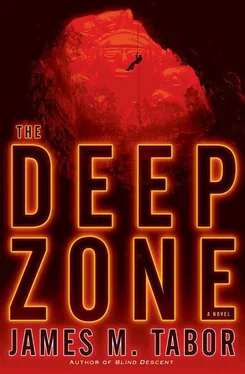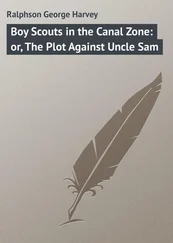Hallie and Bowman looked at each other, then at Cahner.
“Are you sure?” Bowman asked.
“I’m sure.”
“All right, then.” Bowman turned and walked down an easy sand slope to the stream bank. Hallie waited several minutes, then pulled her pack into the water behind her and started off. At first it was easy passage. The water was chest-deep, cold but not painful, and the siphon had the rich, bright smell of pure water tumbling over clean rocks, just like a brook in sunlight on the surface. The haul rope was snug around her waist and buoyancy reduced her pack’s weight, so pulling it along the sandy bottom was not that hard. She sloshed forward, her helmet light illuminating the passage’s walls: red from iron deposits, blue and green from veins of copper.
As she waded farther the water gradually deepened, rising to the middle of her neck, which meant that the floor was sloping down. Now that she had been in it for a while, she began to feel the water’s chill. Sixty-five degrees Fahrenheit didn’t sound all that cold, but it was thirty-three degrees below normal body temperature. With that differential, you lost heat very quickly, and water sucked it away seven times faster than air.
There was no perceptible current here. The walls were less than shoulder width apart. The siphon’s ceiling started sloping downward, so that after a while she had to stoop slightly to clear the top of her helmet. Hunching down dropped her chin to the water’s surface. Occasionally an off-balance step dipped her mouth and nose under, but she was prepared for that. The greater problem was having to move sideways in a modified duck waddle, knees bent, unable to stand fully erect. That, and dragging the pack along, was tiring her more quickly than she had anticipated.
About halfway through she stopped to rest. By then the ceiling had dropped more, forcing her to remove her helmet and carry it. While resting, she unclipped one of the helmet’s lights and held it above the water with her left hand, hanging on to the helmet with her right. Now there was about four inches of space between the water’s surface and the passage’s ceiling. She could breathe only by tilting her head back to keep her nose and mouth out of the water.
Stooped, knees bent, head thrown back, she started off again. If this thing keeps dropping, I’ll be breathing good old H 2O before long . Presently the ceiling did exactly that, dropping another three inches, leaving a space about the width of three fingers between water and rock.
Easy now. You’ve done it before, this is no different, just breathe easy and go slow .
She had forgotten how awful it was negotiating this kind of passage. It was worse than diving, worse than dropping down vertical walls, worse even than acid lakes. It required the utmost control to keep moving along like that, nose and lips scraping the siphon’s rough ceiling, rock fragments falling into her eyes, water lapping into her mouth every so often, and the passage so narrow that she could move forward only by turning her body and edging along sideways.
She inched along— step … breathe … step … breathe —and only when she was stationary and could straighten her knees ever so slightly was she able to bring her nose and mouth out of the water. Then the ceiling dropped more and only her two nostrils were clear of the water’s surface. There was perhaps an inch of space between the water and the rock, no more, so that she was moving with both mouth and eyes underwater. It was hellish. Try as she might, she could not avoid inhaling water, which made her throat constrict. But she could not afford to gasp or cough, because that would have sucked more water into her breathing passages, and it would take only a few teaspoonfuls to trigger involuntary spasms, and those would drown her.
She had passed a point of no return. If she got into trouble here, even with her tremendous breath-hold capacity, she would not make it back to clear space before drowning.
Her right boot toe caught on a rock. She stumbled forward, smacked her forehead against the siphon’s spiky wall, dropped both her hand light and helmet. The impact set off red flashes in her vision and for just a second she was off somewhere else. She came back quickly, on her knees underwater, left hand on one cave wall, right hand on the floor.
She thought she should be able to spot the lights and pick them up, but there was nothing. Either the lights had been damaged or the visibility was so bad that she could not see them. That, she realized, was entirely possible, given how much silt she would have just stirred up.
She would look for the helmet later. And the other light. Right now she needed to breathe. Gently she pushed herself upright, going up inch by inch, feeling along the wall with her left hand, careful to keep her feet in place and steady. Finally she felt the top of her head touch the cave ceiling. She tilted her face upward to get her nose above water and take a breath, but she ended up kissing the rock ceiling. There was no space between it and the rock. The siphon was completely flooded, floor to ceiling. She had fallen away from the air space. When she’d gone down and struck her head, she had lost her orientation, and now, submerged in black water with no perceptible flow, she wasn’t certain which way to go.
Then she remembered her pack. She was tethered to it, and all she had to do was follow the short rope back to the pack, stand up, and find the air space that she knew would be there. She put her hands on her waist, feeling for the rope, but her fingers found nothing.
Must have slipped into a fold in the fabric . She used her fingertips to explore with more pressure. Nothing. She reached behind her, groping for the section of rope that led back to the pack, but it was gone. Her knife, worn on a belt clip when diving, was now in her pack.
She began to feel the first burning in her chest, oxygen depleting, carbon dioxide building.
The pack can’t be more than six or eight feet away. Which way? Don’t know. Go one way. If you don’t find it, go the other. Where the pack is you can stand and breathe .
She felt for clear space, found it, took a step that way—and fell, thrashing, onto the bottom of the siphon. The rope had somehow dropped down from her waist and become wrapped around her ankles. When she tried to move, it tripped her.
The burning in her chest was worse, bigger, hotter. Underwater, she felt for the rope, found it, tried to push it down over her boots, but it would not pass their tops. Tangled or knotted. She found the snag, explored it with her fingers. Not soft and loose. A hard little lump. The force of her stumble had cinched it tight. If it had been big, eleven-mil rope, such a knot would have been easier to loosen. But this was three-millimeter parachute cord. Picking tight knots out of that was hard enough on the surface, in good light.
The burning was spreading out into the rest of her body, heat in her throat, face starting to tingle, eyes twitching. Soon her brain would slow and her muscles would grow clumsy. She picked furiously at the knot. It was no bigger than a pencil eraser and felt hard as a pebble. It was not going to come loose. With the last of her remaining strength she grabbed the bottom wrap of the rope and tried to force it down over her boots, but there was not enough slack for that.
Her diaphragm began the involuntary jerking that signaled the end. Very soon the carbon dioxide level in her system would trip the autonomic breathing reflex. Back arched, she would throw her mouth open wide and suck in a great draft of water, and a few seconds after that, her consciousness would fade and she would drift down to the bottom of the sump, eyes open and staring, hands no longer flailing, feet tied together. They would find her and she would be like Ron Haight, white skin, gray lips, a dead, sodden thing.
Читать дальше












